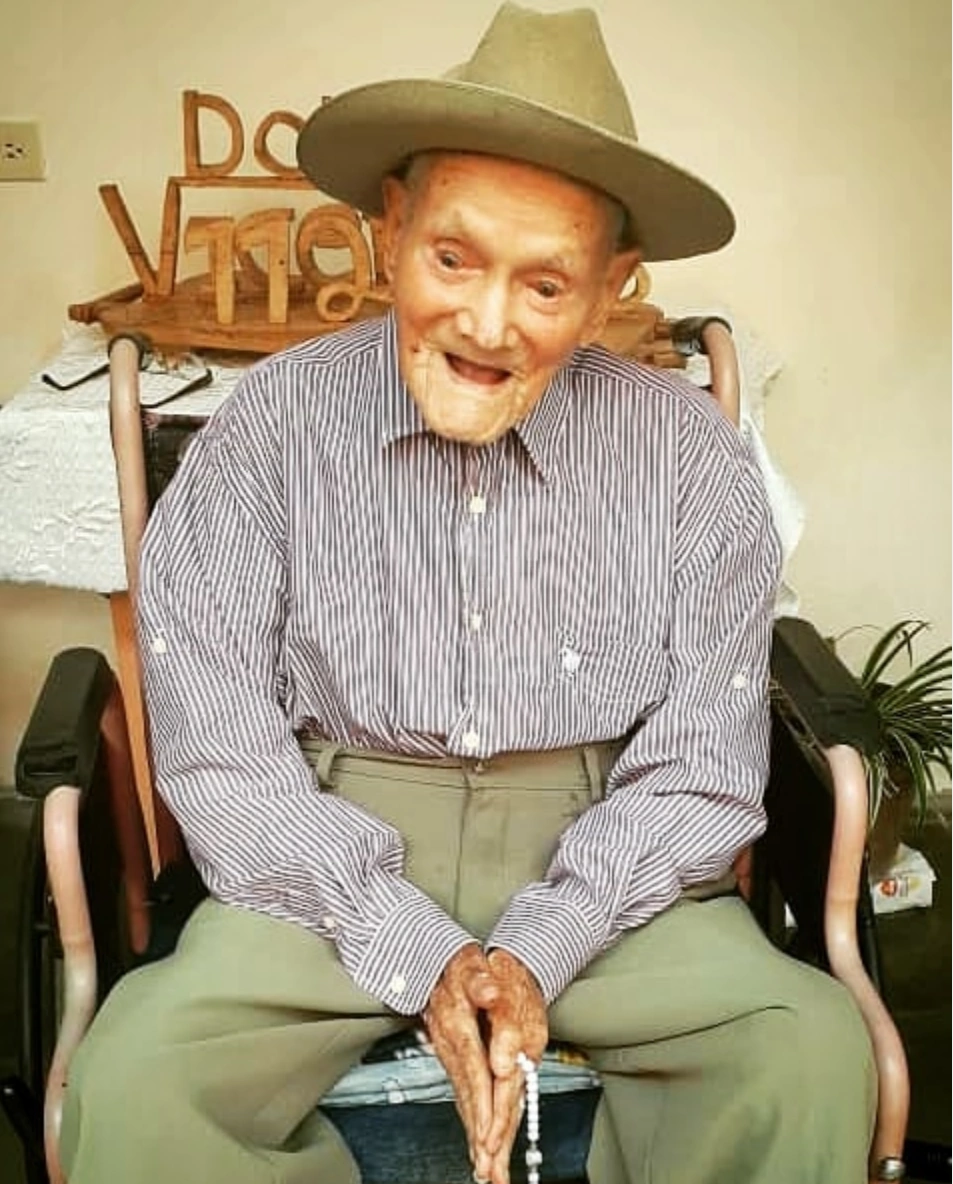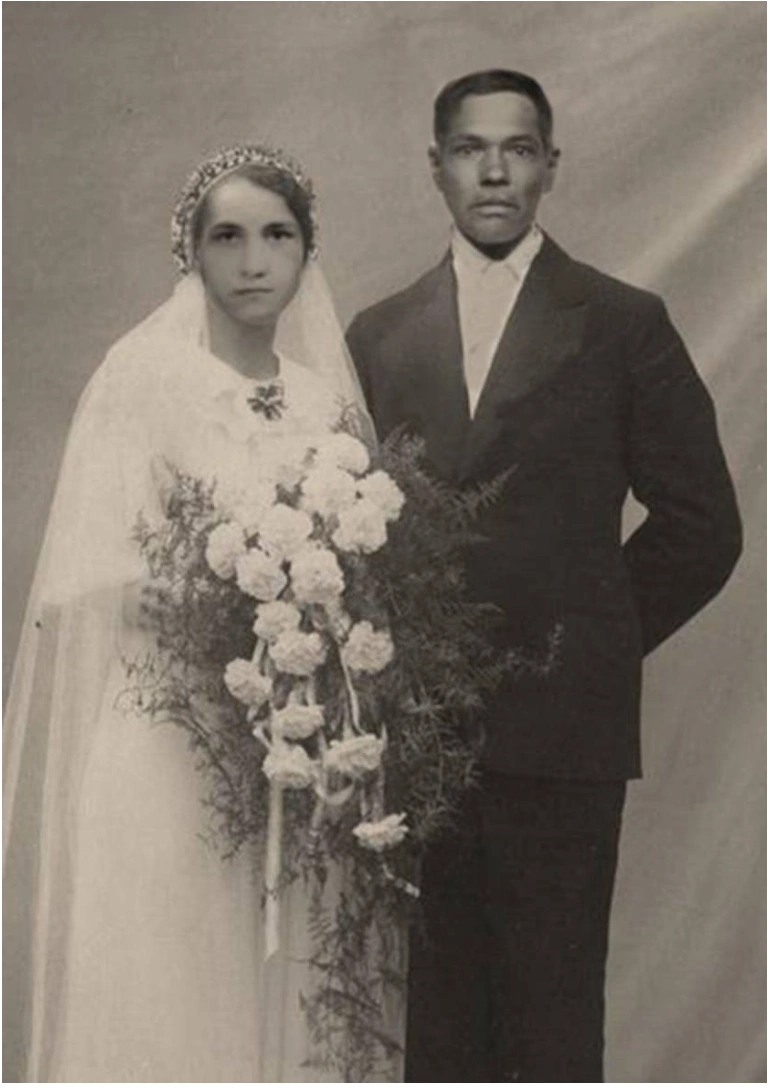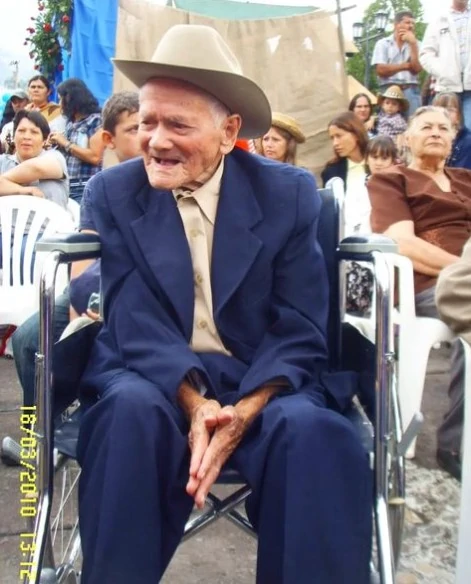Juan Vicente Pérez Mora was a Venezuelan supercentenarian who was recognized by LongeviQuest as the world’s oldest validated living man and the fourth-oldest living person at the time of his passing. He is also the oldest validated person ever from Venezuela, as well as the first validated male supercentenarian from his country.
BIOGRAPHY
Juan Vicente Pérez Mora was born in El Cobre, Tachira, Venezuela, on 27 May 1909. His parents were Euquitio Pérez Mora (1869–1943) and Edelmira Mora Sánchez (1869–1949), and were married on 14 September 1891. Pérez Mora had eight older brothers and one younger sister: Rufino Abigail (born July 1892), Pedro María (1895–c.1962), José Abrahan (1896–c.1959), Rafael Arcangel (born 1897), Salomon (1901–1903), Miguel Arcangel (born 1904), Salomon de Jesus (1906–c.1984), and Maria Betsabe (1912–c.1985).
In 1913, his family moved to Los Paujiles, San José de Bolívar, where they bought a farm. At the age of 4, he had 7 living brothers and one younger sister. While growing up, he would always work barefoot on the farm together with his siblings. While his father and brothers were working in the paddocks, Juan Vicente and his 3-years-older brother Salomón had to bring food to the workers.
In 1917, his father built a farm in La Palma, a place near Laguna de García and Pregonero, where the family later moved. The place had a school run by the locally famous teacher Carmen. The family enrolled Juan Vicente and his younger sister Betzabeth to study with this teacher. Since there were no notebooks, he would buy sheets of paper in stores – worth a copper. However, both the stay in La Palma and the school were short-lived. That climate did not sit well with María Betzabeth, who fell ill shortly after moving. This was the reason their father decided to return to the site of La Hoyada near El Cobre where Juan Vicente was born. As Juan Vicente had barely learned to write his own name, he understood that his future was not in books but in fields, like all his ancestors. He continued his work on the farm; he used to carry the bagasse from the mill, help clean the cane cuts, shell the corn for the arepas, weed the celery in the conuco, and pick coffee. His father had a herd of oxen with which he moved to other villages and hamlets. At the same time, he was searching for land to buy for his children, since he wanted them to have land to cultivate, so that later they could follow in his footsteps.
In 1921, the Spanish Flu reached their village. His mother tried to keep the family safe, but Juan Vicente and some of his brothers fell ill, despite all the precautions. He quickly recovered thanks to his mother’s care, and after opening his eyes he said: “Mom, I’m fine, I feel better now. You will see that I am going to live to a hundred years!”
When Juan Vicente turned 25, his father told him that the company of a woman was necessary to be a complete man, but at the time he still didn’t have a woman whom he liked. Around that time, his brother Miguel lived in the nearby village of Los Paujiles, and Juan Vicente started working for him. One day, while visiting the house of Bartolomé García to carry a load of panela (an unrefined whole cane sugar) sent by his brother Miguel, he saw a girl with whom he fell in love. He learned her name was Ediofina, the daughter of Bartolomé García and Victoria Carrero, and he remembered her, saying: “Oh, how time flies! Like she was just a little cart yesterday” (They had previously met while they were children). A week later, he visited them again with his father, but this time to ask for Ediofina’s hand. After having spoken with Juan Vicente’s father, Bartolomé told Juan Vicente how they would also have to talk with Ediofina’s mother too. Her mother, Victoria, told him that Ediofina was old enough, but the young couple should get to know each other a little better first. After that day, Juan Vicente and Ediofina dated for three years before being married. Weeks before the wedding, they went to the city of La Grita, alongside Ediofina’s mother Victoria. They went to look for the fabrics for Ediofina’s dress and Juan Vicente’s liqui liqui (the Venezuelan national costume for men). On 28 January 1938, the couple was married in the church of Queniquea by Father José Ignacio Moncada. After the marriage, the couple settled for a while in La Hoyada while Juan Vicente was finishing their new house on the Caricuena site. Their first child was born in Los Paujiles – a son whom he named José Juan (José was based on Saint Joseph to whom Juan Vicente became devoted, while Juan was the name of his ancestor from the 18th century).
His children grew up in Caricuena. When he was 39 years old, his 22-month-old daughter, Alix Teresa, passed away; she was the first of his 11 children who passed away. At the beginning of the 1950s, he was hired as a worker for the construction of the road from Queniquea to San José de Bolívar, where he would work on, among others, cutting down hills and trees, moving stones, and flattening land. The construction of the road was quite an event for the region since it would connect San José de Bolívar to the rest of Venezuela. He earned 2 bolívares per day, but if he didn’t manage to do everything requested in one day, he was not paid until the next day. In his 50s, alongside his brothers, he would attend parties at their sister’s house in Queniquea. At the age of 54, he received his first ID Card in La Grita.
RECOGNITION
On 27 May 2019, he celebrated his 110th birthday, becoming the first documented male supercentenarian in Venezuela. On 18 June 2020, he was interviewed by Agencia EFE as the oldest living person in Venezuela.
His age was validated by Latin American Supercentenarians (LAS) on 3 January 2021, thanks to the efforts of Freddy Abreu, Fabrizio Villatoro, Stefan Maglov, and Jeffrey Xu. He was the first validated supercentenarian from Venezuela.
Pérez Mora became the last known surviving man born in the 1900s decade, following the death of Delio Venturotti on 1 June 2022.
On 18 January 2022, following the death of 112-year-old Saturnino de la Fuente García of Spain, Pérez Mora became the oldest living man in the world, at the age of 112 years, 236 days.
ATTRIBUTION
[crp limit=’4′ ]



